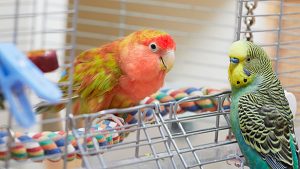The Virginia and Georgia departments of health are investigating a multistate outbreak of psittacosis occurring at two poultry slaughter plants owned by a single corporation. The U.S. Centers for Disease Control (CDC) and the U.S. Department of Agriculture (USDA) are assisting with the investigation.
 Contact a healthcare professional if you have fever, cough, headache, or muscle aches after working at a poultry slaughter plant involved in the outbreak. Tell your healthcare professional that you may have been exposed to psittacosis. Healthcare professionals can treat psittacosis with antibiotics.
Contact a healthcare professional if you have fever, cough, headache, or muscle aches after working at a poultry slaughter plant involved in the outbreak. Tell your healthcare professional that you may have been exposed to psittacosis. Healthcare professionals can treat psittacosis with antibiotics.
Plant management should implement steps to minimize exposures to bird droppings and respiratory secretions to protect their workers.
During August–September 2018, psittacosis cases were reported among workers at two poultry slaughter plants in Virginia and Georgia. A single corporation owns both plants.
Chlamydia psittaci, the type of bacteria that causes psittacosis, was detected by a laboratory test in 10 people. Additional illnesses in workers at the two plants have been identified, although have not been confirmed by the laboratory.
No deaths have been reported.
Virginia and Georgia departments of health are conducting an investigation, and the number of cases is likely to change.
Current evidence indicates that all of the people who have psittacosis work at poultry slaughter plants in two states: Virginia and Georgia. Investigators are still working to understand why the outbreak occurred.
The affected plants in Virginia and Georgia voluntarily suspended operations for cleaning.
On September 8, 2018, the affected plant in Virginia suspended operations. The plant reopened on September 18, 2018.
On September 15, 2018, the affected plant in Georgia suspended operations. The plant reopened on September 19, 2018.
Plant management held town hall meetings in both plants to inform their workers about the outbreak.
CDC will provide updates when more information is available.
The most common way someone gets infected with the bacteria that cause psittacosis (Chlamydia psittaci) is by breathing in dust containing dried secretions (e.g., droppings, respiratory) from infected birds. There is no evidence that these bacteria can spread by preparing or eating chicken meat.
It is rare for psittacosis to spread from person to person. In this outbreak, infection among family members who are not workers at the affected plants has not been reported.

